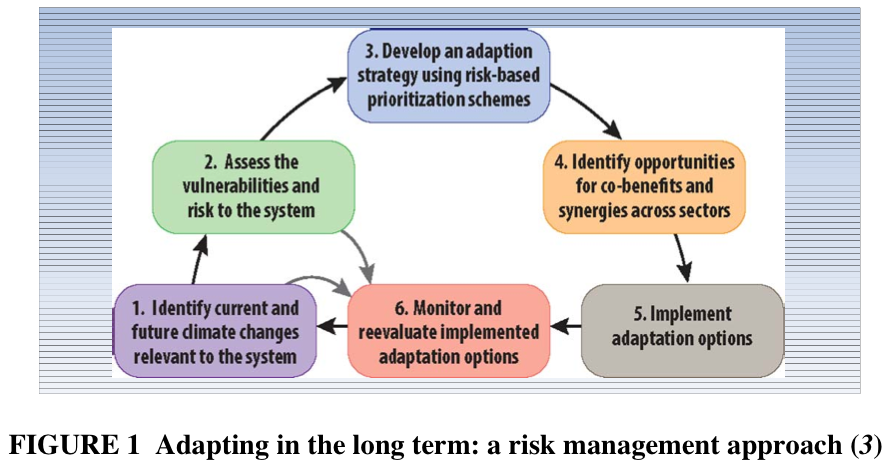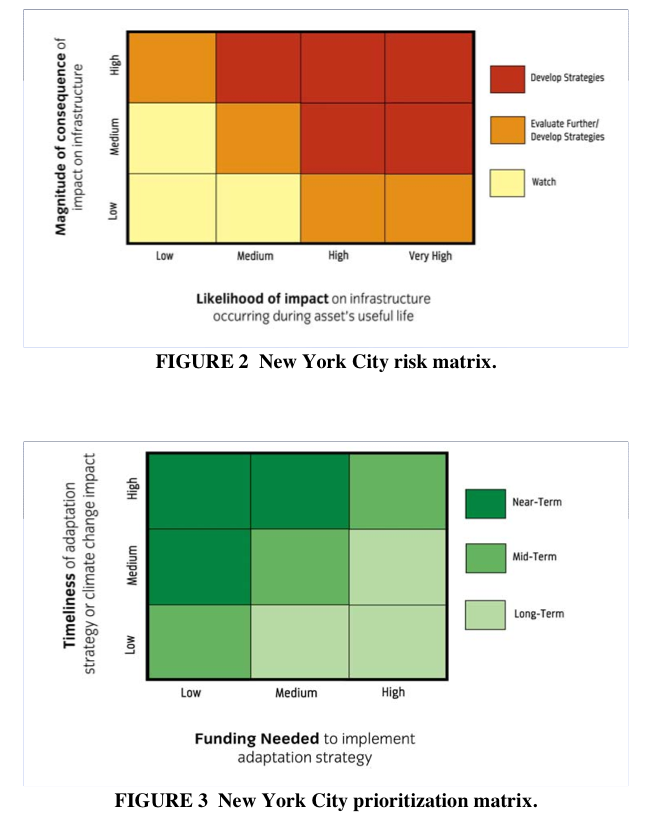TRANSPORTATION RESEARCH BOARD
Report Dated June 2011
Introduction
Joyce Wenger, Wenger and Wenger Consulting
Regardless of what climate change mitigation strategies are adopted, the shorter-term effects of climate change mean that transportation policy makers, planners, and operators—across all modes—need to make changes to adapt to these effects. This E-Circular on adaptation, developed under the auspices of the TRB Special Task Force on Climate Change and Energy, is a companion to the TR News Special Edition issue of May–June 2010 on climate change mitigation. This document focuses on transportation adaptation practices that can be implemented to yield benefits now and in the longer term. It highlights what climate change adaptation means for the transportation industry and why it is so important.
This document begins with an overview of adaptation issues and a summary of the numerous recommendations for adaptation identified in the 2008 TRB Special Report 290. Following that is a series of articles addressing work currently underway at the federal level, at the state level, and in the United Kingdom. Projects at the federal level, being pursued by the FHWA’s Sustainable Transport and Climate Change Team, address a broad range of adaptation issues facing state departments of transportation and metropolitan planning organizations, including the issue of risk and vulnerability, which is being addressed by an assessment tool that FHWA is testing in a number of states. The United Kingdom has established requirements for addressing climate change and adaptation that are currently being implemented at various levels of the government; its focus on coordination among various sectors (including transportation) provides interesting concepts for the United States to consider. The next article highlights quite a number of specific adaptation strategies that have been implemented by various states in the United States that are providing successful results and that bear consideration by agencies across the country. An article on aviation focuses on some of the unique aspects of dealing with adaptation in relation to airport operations, when many constituents are involved—the ideas on communication, cooperation, and collaboration will be of interest to those dealing with other transportation modes. The final feature article highlights the need for transportation planners and operators to work and plan in close cooperation with a range of agencies and across regional boundaries, and to include weather forecasters and emergency responders.
Sidebars throughout this E-Circular highlight the real impacts of flooding due to climate change, summarize the impacts of climate change on freight operations, and provide information about an upcoming international scan on climate change adaptation. The document concludes with a list of research needs and opportunities identified by the TRB Special Task Force on Climate Change and Energy.
Adapting to Climate Change
Another Challenge for the Transportation Community
Henry G. Schwartz, Jr., NAE Consultant
The transportation planners, designers, and operators of this nation’s transportation systems face many daunting concerns, not the least of which is funding to maintain and improve the country’s infrastructure and competitiveness. To these concerns is now added climate change or global warming. This paper does not address the science of climate change or the issue of mitigation to reduce the emissions of greenhouse gases (GHG). Rather it accepts the current state of knowledge on global warming and focuses on adaptation. How does the transportation community develop solutions and approaches that will minimize or eliminate the impact of climate change? To many, this question is a paramount one as the nation builds, rebuilds, operates, and maintains its transportation infrastructure.
Even if there are major strides in the mitigation of GHG emissions, the world very likely will be facing a significantly altered climate in coming decades with impacts that test our current ability to forecast accurately. Nonetheless, one can develop scenarios of probable impacts and how the United States might adapt to conditions that could occur 25 to 50 years hence. While most of these scenarios deal with transportation, a few others are included to demonstrate the breadth of the impacts.
- Rising sea levels will place people, homes, businesses, and infrastructure at risk, especially along the Atlantic and Gulf Coasts and Alaska. Coupled with land subsidence, prevalent in many areas such as the Gulf Coast, the impacts will be felt tens of miles inland. More intense hurricanes packing higher wind speeds coming on shore on higher sea levels are a recipe for even greater disaster. Efforts to restore barrier islands to protect the mainland will be extensive and expensive. Sea walls along miles of shoreline may protect densely populated areas, but relocation inland of some communities may well be necessary. Transportation systems must be designed to permit faster and orderly evacuation of coastal communities. Are there new structural and nonstructural solutions to these problems? Can more resilient systems be developed that can withstand a certain amount of inundation during high storm surges, but restore service and utility rapidly?
- Heat will be a growing concern throughout much of the United States. Warmer temperatures and longer heat waves will create demand for more air conditioning, even in northern latitudes such as New England. By the end of the century, the climate in Illinois is forecast to be like Texas today. Sustained higher temperatures will stress pavement materials, bridge structures, and rails. The impact of prolonged heat waves will impact the most vulnerable of our population, the poor, the elderly, and the very young. With rising temperatures will come greater desertification and drought, particularly in the southwest. Water scarcity, already an issue in those regions, will necessitate changes in water laws and interstate compacts. Lower air densities will reduce aircraft takeoff payloads and require longer runways.
- Water levels in the Great Lakes will drop, impacting shipping through the Saint Lawrence Seaway, but elsewhere higher temperatures of inland waterways and the Arctic will lengthen the shipping season. Power plant efficiencies will decrease absent new technologies to improve heat transfer systems. Construction and other outside work will increasingly be performed in evening and nighttime hours to protect workers’ health. Are there more effective ways to protect the most vulnerable from the impacts of heat waves? Can more heat resistant materials be developed with which to pave our highways and build our infrastructure? Can new developments in aerodynamic design improve aircraft liftoff capacities?
- With the shift in temperatures, there will be a concomitant migration of plant, insect, and disease vectors northward in the United States. The unprecedented infestation by the log pole pine beetle in the Rocky Mountains and the spruce beetle in Alaska will have eliminated those native trees, creating a tinderbox for forest fires. As amply demonstrated in California, Florida, and Colorado, such fires directly impact transportation visibility and are invariably followed by rainstorms generating mudslides that destroy rail lines and highways. Crops once confined to southern climes will now be grown farther north, and the growing season may well permit two harvests per year in new locales. Conversely, drought and water reallocations may change the crops grown in some of the nation’s most productive regions such as the southwest. Weeds and other invasive plant species will rapidly move northward as will disease vectors thereby placing larger populations at risk. It is likely that natural mutations of some of these diseases will create new problems. Plant science will be particularly challenged to arrest some of these migrations as will the health sciences. On a positive note, warmer winters may well reduce the need for and cost of snow and ice removal while improving vehicle safety.
- Increased intensity of precipitation in many parts of the continental United States and perhaps Alaska will place new stresses on the environment. Rainfall frequency– duration profiles will have changed very significantly: more frequent, heavier storms. Culverts, stormwater drainage systems, and natural drainage basins will all experience overloads with the increase in heavy rainfall. Infrastructure, such as bridges, levees, and dikes, will have to be designed to withstand greater hydraulic loads. Hydrological analyses will be revised, flood plains redefined, and new engineering standards developed. Social and environmental questions must be addressed as the nation wrestles with the entire issue of sustainable development especially in coastal communities. See the sidebar (page 10), which graphically shows effects of increased precipitation.
- Alaska is a special case as temperatures are expected to rise much more rapidly in far northern regions. The Arctic ice sheet will retreat even farther, opening the Northwest Passage to shipping but exposing the northern slope of Alaska to greater storm erosion. Many native villages will have to be relocated. Infrastructure built on permafrost will be endangered, necessitating new structural approaches and replacement. Cold weather roads will disappear, creating yet another challenge to accessing parts of Alaska by rail or road.
If these scenarios provide a window into the climate of the future, it behooves those involved with the planning, design, construction, and operation of infrastructure systems to understand how climate change will impact those systems. As we move through the 21st century, how can we rehabilitate, reconstruct, build, operate and maintain systems that are more resilient to the impacts of climate change? Nowhere will the impacts of climate change be more apparent than on the vast transportation network of this country.
Read full report (PDF) here: Adapting Transportation to the Impacts of Climate Change
About The Transportation Research Board
www.trb.org
“The Transportation Research Board is one of six major divisions of the National Research Council, which serves as an independent adviser to the federal government and others on scientific and technical questions of national importance. The National Research Council is jointly administered by the National Academy of Sciences, the National Academy of Engineering, and the Institute of Medicine. The mission of the Transportation Research Board is to provide leadership in transportation innovation and progress through research and information exchange, conducted within a setting that is objective, interdisciplinary, and multimodal.”
Tags: Climate Change, emergency preparedness, transportation, TRB







 RSS Feed
RSS Feed